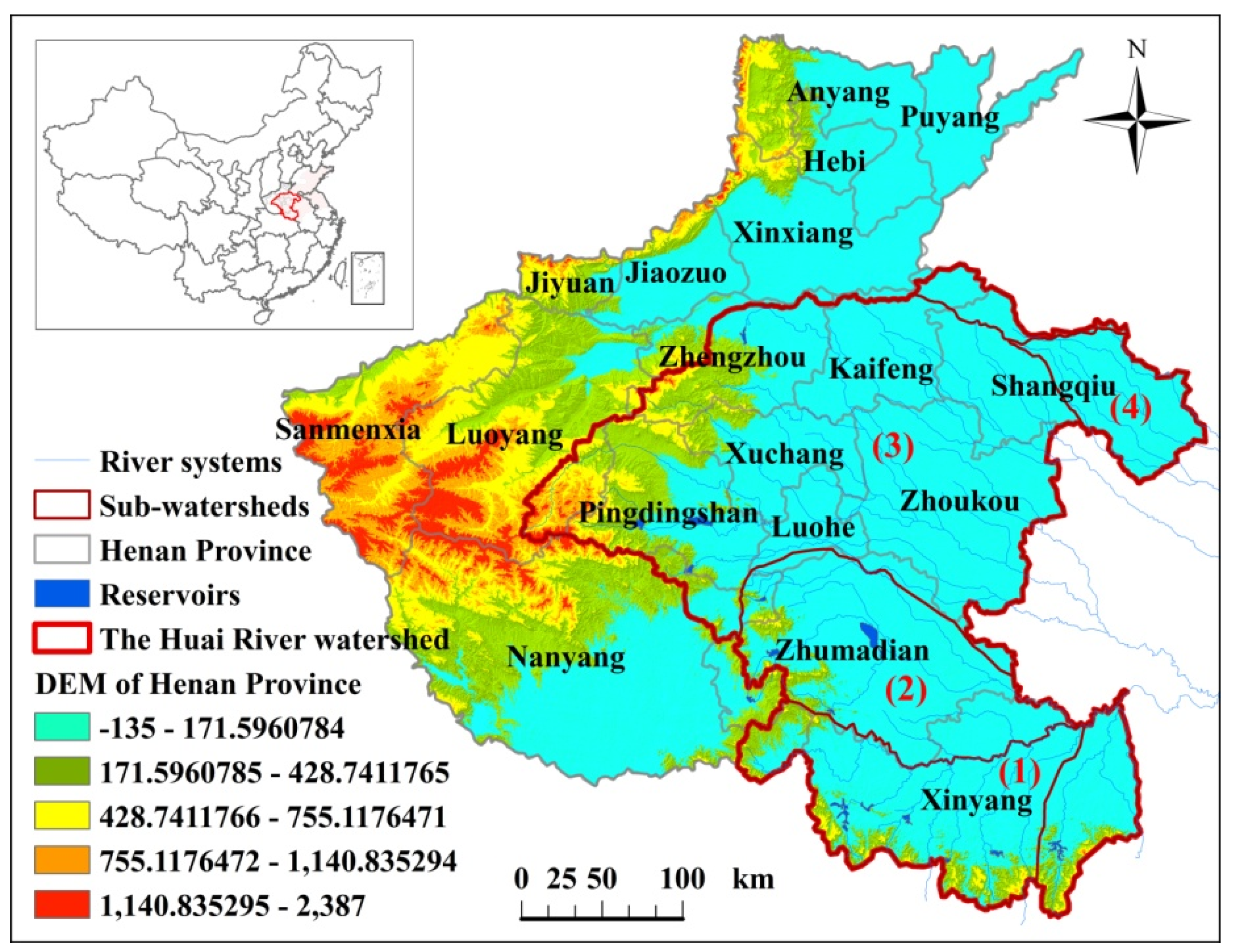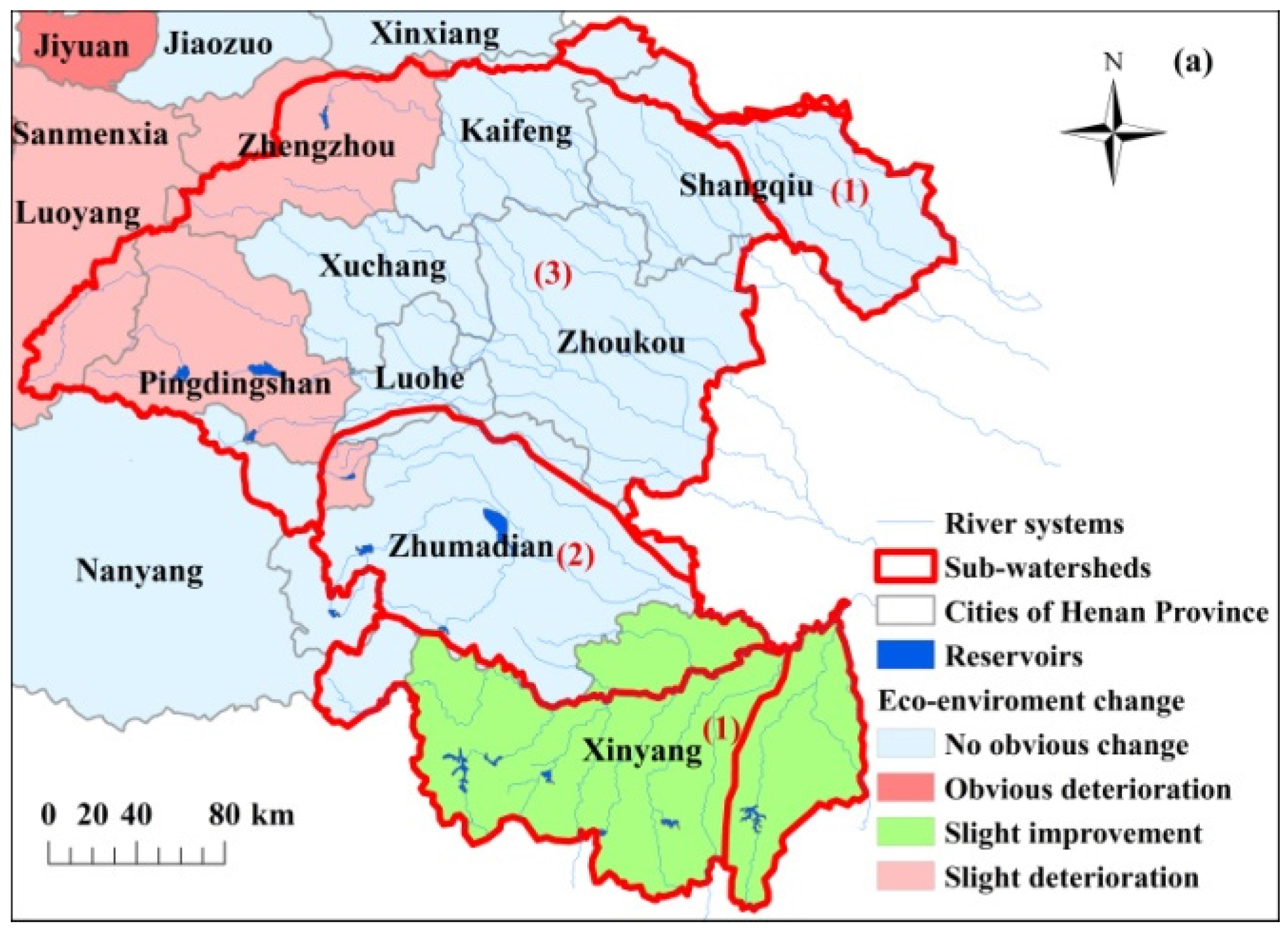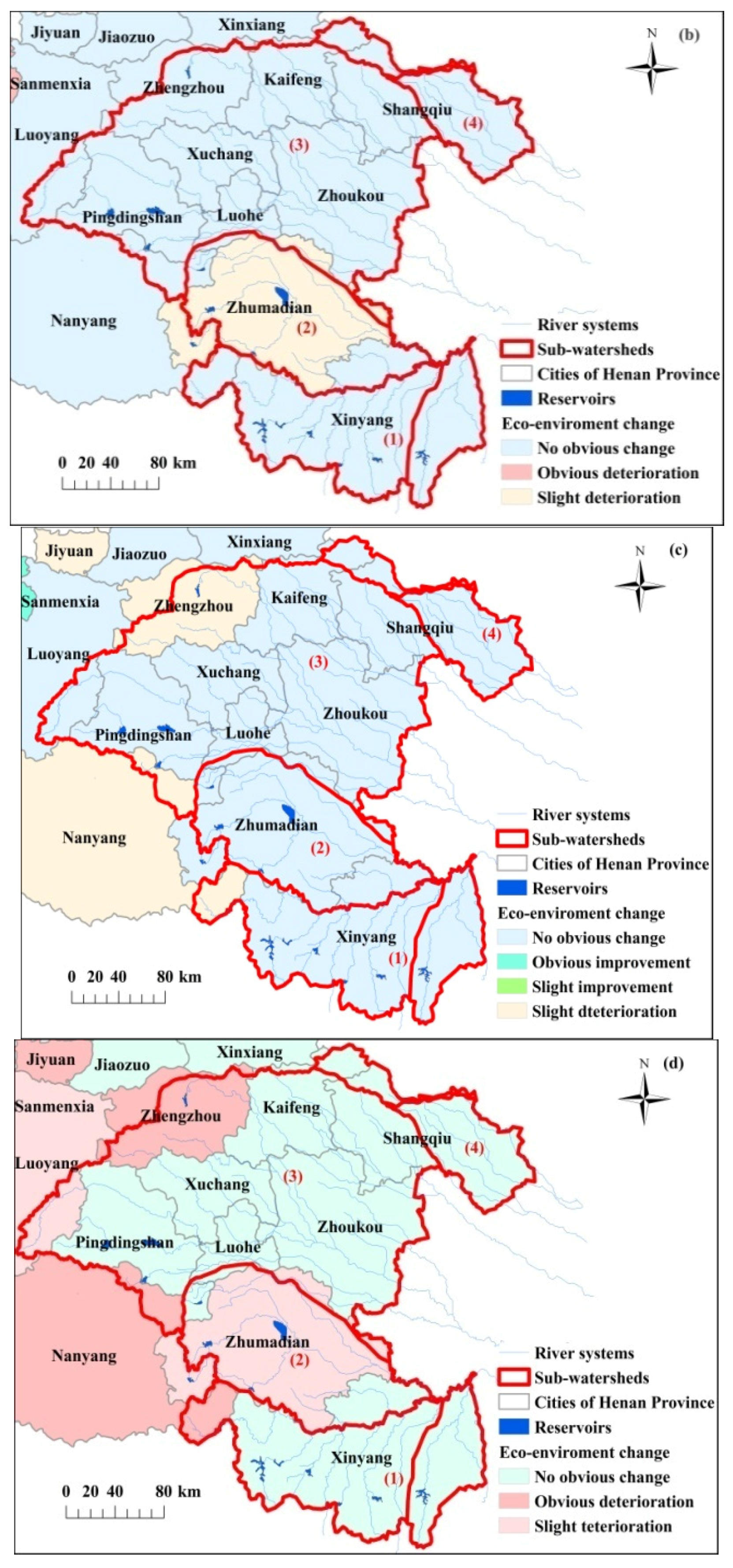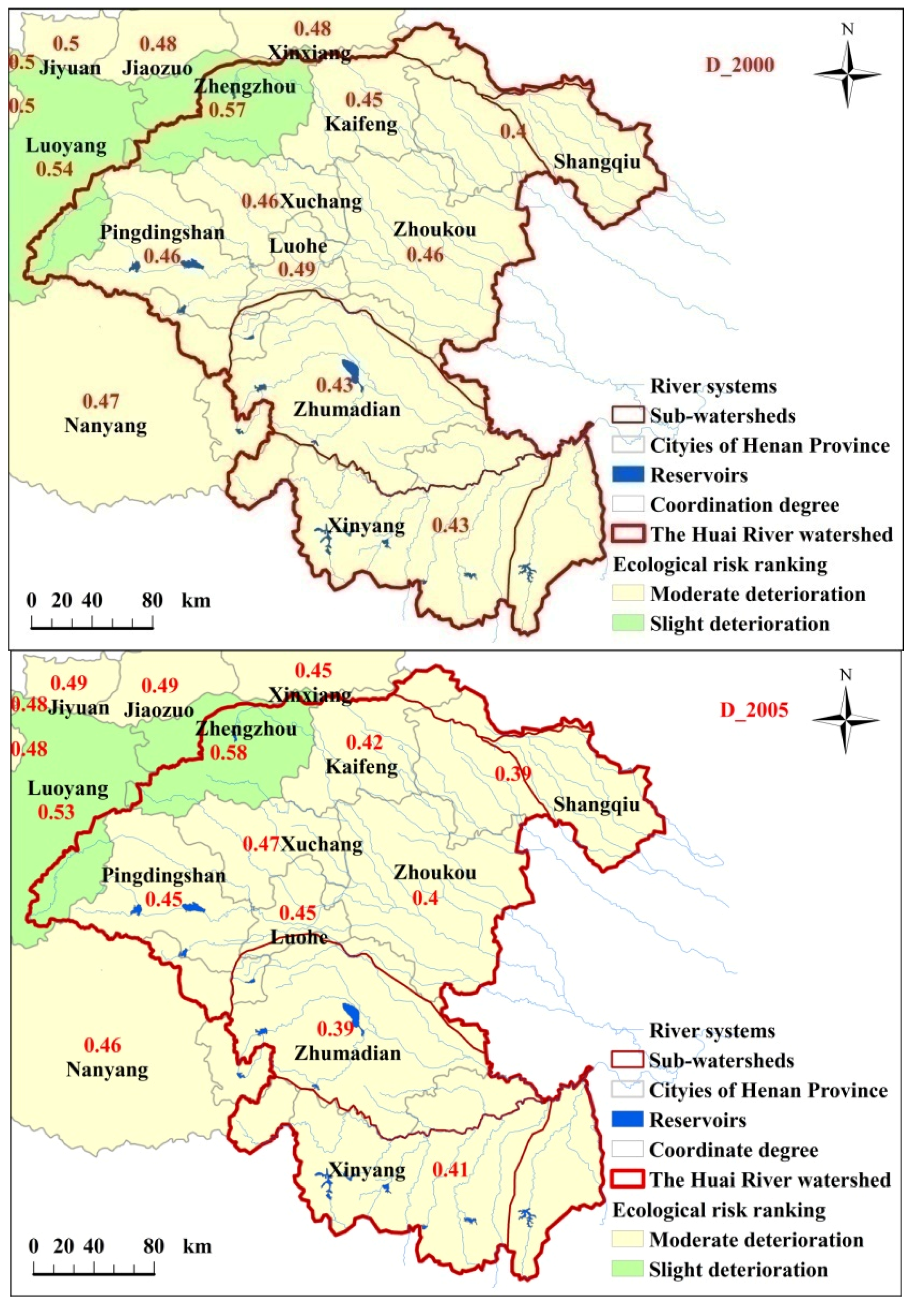Regional Ecological Risk Assessment in the Huai River Watershed during 2010–2015
Abstract
:1. Introduction
2. The Methods and Datasets Description
2.1. The Study Area and Dataset Description
2.2. The Integrated Methodology for Ecological Risk Assessment
2.3. The Assessment Methods for Watershed EcosystemVulnerablity to Human Activities
2.4. The Assessment Methodology for Human Contributors
3. Results
3.1. Spatio-Temperal Distributions of Eco-environmental Quality in the Huai River Watershed in Henan Province
3.2. Spatio-Temperal Distributions of Ecological Risk in the Huai River watershed in Henan Province
4. Conclusions and Discussion
Acknowledgments
Author Contributions
Conflicts of Interest
References
- Parmesan, C.; Yohe, G. A globally coherent fingerprint of climate change impacts across natural systems. Nature 2003, 421, 37–42. [Google Scholar] [CrossRef] [PubMed]
- Sala, O.E.; Chapin, F.S.; Armesto, J.J.; Berlow, E.; Bloomfield, J.; Dirzo, R.; Huber-Sanwald, E.; Huenneke, L.F.; Jackson, R.B.; Kinzig, A.; et al. Biodiversity—Global biodiversity scenarios for the year 2100. Science 2000, 287, 1770–1774. [Google Scholar] [CrossRef] [PubMed]
- Xu, X.; Lin, H.; Fu, Z. Probe into the method of regional ecological risk assessment—A case study of wetland in the Yellow River Delta in China. J. Environ. Manag. 2004, 70, 253–262. [Google Scholar] [CrossRef] [PubMed]
- The United Nations (UN). The United Nations World Water Development Report: Water for People, Water for life 2003 report. WWA Programme; UN: New York, NY, USA, 2003. [Google Scholar]
- WHO/UNICEF (World Health Organization/United Nations Children’s Fund). Global Water Supply and Sanitation Assessment 2000 Report; WHO/UNICEF: Geneva, Switzerland, 2000. [Google Scholar]
- Heathcote, I.W.; Edwards, J.R.; Greener, H.; Coombs, H.M. Integrated Watershed Management: Principles and Practice; Taylor & Francis: Abingdon-on-Thames, UK, 1998. [Google Scholar]
- Pitt, R. Integrated Watershed Management. In World Environmental and Water Resource Congress 2006: Examining the Confluence of Environmental and Water Concerns; American Society of Civil Engineers: Reston, VA, USA, 2006; pp. 1–10. [Google Scholar]
- Dixon, J.A.; Easter, K.W. Integrated watershed management: An approach to resource management. In Watershed Resource Management: Studies from Asia and the Pacific; Institute of Southeast Asian Studies: Singapore, 1991; pp. 3–15. [Google Scholar]
- Bulkley, J.W. Integrated watershed management: Past, present, and future. J. Contemp. Water Res. Educ. 2011, 100, 3. [Google Scholar]
- Hunsaker, C.T.; Graham, R.L.; Suter, G.W.; O’Neill, R.V.; Barnthouse, L.W.; Gardner, R.H. Assessing ecological risk on a regional scale. Environ. Manag. 1990, 14, 325–332. [Google Scholar] [CrossRef]
- Xu, Y.; Gao, J.; Zhao, J.; Chen, J. The research progress and prospect of watershed ecological risk assessment. Acta Ecol. Sin. 2012, 32, 284–292. (In Chinese) [Google Scholar]
- Fernández-Luqueño, F.; López-Valdez, F.; Gamero-Melo, P.; Luna-Suárez, S.; Aguilera-González, E.N.; Martinez, A.I.; Garcia-Guillermo, M.D.S.; Hernández-Martínez, G.; Herrera-Mendoza, R.; Álvarez-Garza, M.A.; et al. Heavy metal pollution in drinking water-a global risk for human health: A review. Afr. J. Environ. Sci. Technol. 2013, 7, 567–584. [Google Scholar]
- Alcamo, J.; Flörke, M.; Märker, M. Future long-term changes in global water resources driven by socio-economic and climatic changes. Hydrol. Sci. J. 2007, 52, 247–275. [Google Scholar] [CrossRef]
- Wang, G.; Cheng, G.; Qian, J. Several problems in ecological security assessment research. Chin. J. Appl. Ecol. 2003, 14, 1551–1556. (In Chinese) [Google Scholar]
- Fu, B.; Liu, G.; Wang, X.; Ouyang, Z. Ecological issues and risk assessment in China. Int. J. Sustain. Dev. World Ecol. 2004, 11, 143–149. [Google Scholar] [CrossRef]
- Serveiss, V.B. Applying ecological risk principles to watershed assessment and management. Environ. Manag. 2002, 29, 145–154. [Google Scholar] [CrossRef]
- Detenbeck, N.E.; Batterman, S.L.; Brady, V.J.; Brazner, J.C.; Snarski, V.M.; Taylor, D.L.; Thompson, J.A.; Arthur, J.W. A test of watershed classification systems for ecological risk assessment. Environ. Toxicol. Chem. 2000, 19, 1174–1181. [Google Scholar] [CrossRef]
- Fu, Z.; Xu, X. Regional ecological risk assessment. Adv. Earth Sci. 2001, 16, 267–271. (In Chinese) [Google Scholar]
- Gibbs, M. Ecological risk assessment, prediction, and assessing risk predictions. Risk Anal. 2011, 31, 1784–1788. [Google Scholar] [CrossRef] [PubMed]
- Adams, S.M.; Power, M. Assessing the current status of ecological risk assessment. Environ. Manag. 1997, 21, 825–830. [Google Scholar]
- Zhou, T.; Meng, J. Research progress in regional ecological risk assessment methods. Chin. J. Ecol. 2009, 28, 31. [Google Scholar]
- Lu, H.; Zeng, G.; Xie, G.; Zhang, S.; Huang, G.; Jin, X.; Liu, H. The regional ecological risk assessment of the Dongting Lake watershed. Acta Ecol. Sin. 2002, 23, 2520–2530. [Google Scholar]
- Xu, X.; Yang, G.; Tan, Y.; Zhuang, Q.; Li, H.; Wan, R.; Su, W.; Zhang, J. Ecological risk assessment of ecosystem services in the Taihu Lake Basin of China from 1985 to 2020. Sci. Total Environ. 2016, 554, 7–16. [Google Scholar] [CrossRef] [PubMed]
- Linkov, I.; Loney, D.; Cormier, S.; Satterstrom, F.K.; Bridges, T. Weight-of-evidence evaluation in environmental assessment: Review of qualitative and quantitative approaches. Sci. Total Environ. 2009, 407, 5199–5205. [Google Scholar] [CrossRef] [PubMed]
- Jiang, Y.; Liu, Y.; Ying, G.; Wang, H.; Liang, Y.; Chen, X. A new tool for assessing sediment quality based on the Weight of Evidence approach and grey TOPSIS. Sci. Total Environ. 2015, 537, 369–376. [Google Scholar] [CrossRef] [PubMed]
- Moraes, R.; Molander, S. A procedure for ecological tiered assessment of risks (PETAR). Hum. Ecol. Risk Assess. 2004, 10, 349–371. [Google Scholar] [CrossRef]
- Brien, G.C.O.; Wepener, V. Regional-scale risk assessment methodology using the Relative Risk Model (RRM) for surface freshwater aquatic ecosystems in South Africa. Water SA 2012, 38, 153–166. [Google Scholar]
- Liu, J.; Chen, Q.; Li, Y. Ecological risk assessment of water environment for Luanhe River Basin based on relative risk model. Ecotoxicology 2010, 19, 1400–1415. [Google Scholar] [CrossRef] [PubMed]
- Pollino, C.A.; Woodberry, O.; Nicholson, A.; Korb, K.; Hart, B.T. Parameterisation and evaluation of a Bayesian network for use in an ecological risk assessment. Environ. Model. Softw. 2007, 22, 1140–1152. [Google Scholar] [CrossRef]
- Ministry of Environmental Protection of the People’s Republic of China. Technical Criterion for Eco-Environmental Status Evaluation (HJ/T192-2006); China Environmental Science Press: Beijing, China, 2006. (In Chinese)
- Wang, S.; Fang, C.; Wang, Y. Quantitative investigation of the interactive coupling relationship between urbanization and eco-environment. Acta Sin. 2015, 35, 2244–2254. (In Chinese) [Google Scholar]
- Meng, J.; Zhao, C. Research progress on index system of regional ecological risk assessment. Chin. J. Appl. Ecol. 2009, 20, 983–990. (In Chinese) [Google Scholar]
- Hu, B.; Zhao, X.; Liu, H.; Liu, Z.; Song, T.; Wang, Y.; Tang, L.; Xia, X.; Tang, G.; Ji, D.; et al. Quantification of the impact of aerosol on broadband solar radiation in North China. Sci. Rep. 2017, 7, 44851. [Google Scholar] [CrossRef] [PubMed]
- Gao, C.; Chen, X.; Wei, C.; Peng, X. Application of entropy weight and fuzzy synthetic evaluation in urban ecological security assessment. Chin. J. Appl. Ecol. 2006, 17, 1923–1927. (In Chinese) [Google Scholar]
- Huang, H.; Peng, X.; Kong, F.; Zhang, L. Evaluation of ecological economy index in the Poyang Lake ecological economic zone. Acta Ecol. Sin. 2014, 34, 3107–3114. (In Chinese) [Google Scholar] [CrossRef]
- Mcdonald, K.S.; Ryder, D.S.; Tighe, M. Developing best-practice Bayesian Belief Networks in ecological risk assessments for freshwater and estuarine ecosystems: A quantitative review. J. Environ. Manage. 2015, 154, 190–200. [Google Scholar] [CrossRef] [PubMed]
- Ni, J.R.; Xue, A. Application of artificial neural network to the rapid feedback of potential ecological risk in flood diversion zone. Eng. Appl. Artif. Intell. 2003, 16, 105–119. [Google Scholar] [CrossRef]
- Munns, W.R., Jr.; Rea, A.W.; Suter, G.W., II; Martin, L.; Blake-Hedges, L.; Crk, T.; Davis, C.; Jordan, S.; Mahoney, M.; Barron, M.G. Ecosystem services as assessment endpoints for ecological risk assessment. Integr. Environ. Assess. Manag. 2016, 12, 522–528. [Google Scholar] [CrossRef] [PubMed]
- Faber, J.H.; Van, W.J. Elaborations on the use of the ecosystem services concept for application in ecological risk assessment for soils. Sci. Total Environ. 2012, 415, 3–8. [Google Scholar] [CrossRef] [PubMed]
- Graham, R.L.; Hunsaker, C.T.; O’Neill, R.V.; Jackson, B.L. Ecological Risk Assessment at The Regional Scale. Ecol. Appl. A Publ. Ecol. Soc. Am. 1991, 1, 196–206. [Google Scholar] [CrossRef] [PubMed]
- Leuven, R.S.E.W.; Poudevigne, I. Riverine landscape dynamics and ecological risk assessment. Freshw. Bio. 2010, 47, 845–865. [Google Scholar] [CrossRef]






| Ecological Risk Ranking | Threshold Index (D) | Sub-Types of Ecological Risk | Sub-Threshold Indicators |
|---|---|---|---|
| Severe degradation | 0 < D ≤ 0.3 | Delayed urbanization | g(E) − f(U) > 0.1 |
| Delayed eco-environment | f(U) − g(E) > 0.1 | ||
| Severe degradation | 0 ≤ |f(U) − g(E)| < 0.1 | ||
| Moderate degradation | 0.3 < D ≤ 0.5 | Delayed urbanization | g(E) − f(U) > 0.1 |
| Delayed eco-environment | f(U) − g(E) > 0.1 | ||
| Moderate degradation | 0 ≤ |f(U) − g(E)| < 0.1 | ||
| Slight degradation | 0.5 < D ≤ 0.8 | Delayed urbanization | g(E) − f(U) > 0.1 |
| Delayed eco-environment | f(U) − g(E) > 0.1 | ||
| Slight degradation | 0 ≤ |f(U) − g(E)| < 0.1 | ||
| No risk | 0.8 < D ≤ 1 | Delayed urbanization | g(E) − f(U) > 0.1 |
| Delayed eco-environment | f(U) − g(E) > 0.1 | ||
| No risk | 0 ≤ |f(U) − g(E)| < 0.1 |
| Quantification of Human Systems | Indicators | Weight Coefficients | |
|---|---|---|---|
| Contributors from human social system |
| Population density (cap/km2) | 0.09 |
| Percentage of non-agricultural population (%) | 0.04 | ||
| Employed persons in tertiary industry (%) | 0.01 | ||
| Urbanization area (m2/cap) | 0.04 | |
| Road area (m2/cap) | 0.05 | ||
| Residential area (m2/cap) | 0.22 | ||
| Per capital GDP (¥) | 0.05 | |
| Gross value of industrial output (¥/cap) | 0.13 | ||
| Urbanpercapitadisposable income (¥) | 0.00 | ||
| Ratio of primary and secondary industries (%) | 0.00 | ||
| Total financial revenue (¥/cap) | 0.17 | ||
| Total retail sales of consumer goods (¥) | 0.02 | |
| Regular institutions of higher education (104 persons) | 0.11 | ||
| Internet users (104 persons) | 0.06 | ||
| Employed persons in health institutions(104 persons) | 0.01 |
© 2017 by the authors. Licensee MDPI, Basel, Switzerland. This article is an open access article distributed under the terms and conditions of the Creative Commons Attribution (CC BY) license (http://creativecommons.org/licenses/by/4.0/).
Share and Cite
Lu, Y.; Qin, F.; Chang, Z.; Bao, S. Regional Ecological Risk Assessment in the Huai River Watershed during 2010–2015. Sustainability 2017, 9, 2231. https://doi.org/10.3390/su9122231
Lu Y, Qin F, Chang Z, Bao S. Regional Ecological Risk Assessment in the Huai River Watershed during 2010–2015. Sustainability. 2017; 9(12):2231. https://doi.org/10.3390/su9122231
Chicago/Turabian StyleLu, Yan, Fen Qin, Zhongbing Chang, and Shuming Bao. 2017. "Regional Ecological Risk Assessment in the Huai River Watershed during 2010–2015" Sustainability 9, no. 12: 2231. https://doi.org/10.3390/su9122231




